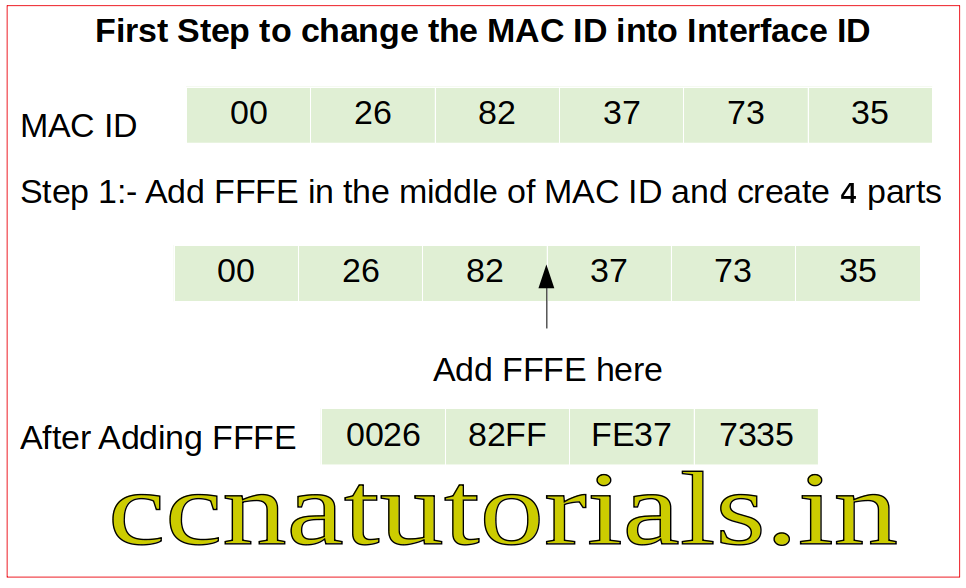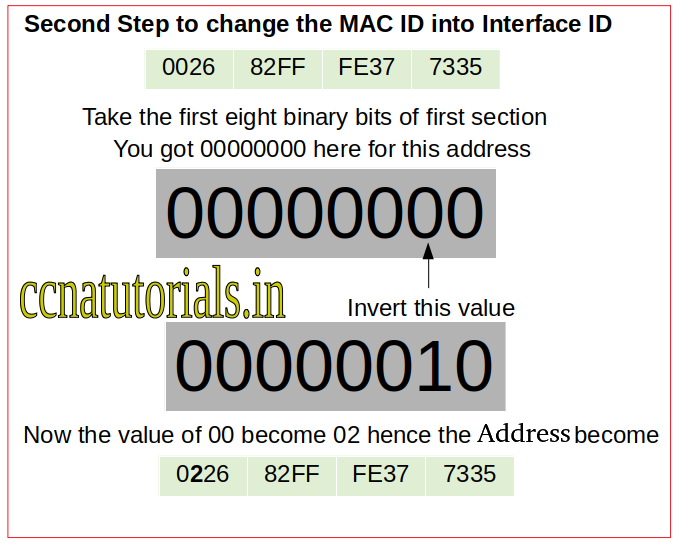In this article I explain the Working of IPv6 address in computer networking for CCNA 200-301. The types of IPv6 addresses and expressions are pre-requisit to understand the Working of IPv6 address in computer networking. You can read the IPv6 address and IPv6 expressions by clicking on the links respectively.
Just like IPv4 the new address system IPv6 provides the data packets flow in a network . We require to configure the nodes and networking device for Working of IPv6 address in computer networking. The main purpose of any internet protocol is to identify the source and destination.
After finding the source and destination the data packets forwarded to destination. This process goes from various processes and follows multiple protocols in internetwork. Working of IPv6 in internetwork depends on many factors. First thing is the allotment of IPv6 address to all devices. We use the stateless auto-configuration and DHCP to assign the IPv6 addresses.
Enable the IPv6 function for Working of IPv6 address in computer networking
All networking devices remains disable for IPv6 function by default. We require to enable the IPv6 traffic forwarding manually in routers. To enable the IPv6 packet forwarding run the below command in routers.
Router>en Router#config t Enter configuration commands, one per line. End with CNTL/Z. Router(config)#IPv6 unicast-routing Router(config)#do wr Building configuration... [OK] Router(config)#exit Router#
The above command enable the IPv6 traffic forwarding. As I told earlier by default all functions of IPv6 are disable in any router. So we need to enable the IPV6 traffic forwarding on each interface also. To do that we require to run the following commands on each interface.
Router>en Router#config t Router(config)#interface gigabitethernet0/0/0 Router(config-if)#IPv6 address 3241:00BD:0000:A000:0000:0000:0101:0012/64 Router(config-if)#IPv6 address 3241:00BD:0000:A000:0000:0000:0101:0012/64 eui-64 Router(config-if)#do wr Building configuration... [OK] Router(config-if)#exit Router(config)#exit Router#
In above command I added EUI-64 option. EUI stands for Extended Unique Identifier format which allow registration of MAC address and make the interface ID. Another command to enable the IPv6 traffic forwarding is enable see the below example.
Router# Router#config t Router(config)#interface gigabitethernet0/0/0 Router(config-if)#IPv6 enable Router(config-if)#do wr Building configuration... [OK] Router(config-if)#exit Router(config)#exit Router#
Configuration of Stateless Autoconfiguration (SLAAC) EUI-64 for Working of IPv6 address in computer networking.
Stateless autoconfiguration allows the device to introduce itself with a link-local unicast as well as with global unicast IPv6 addresses. The interface ID of an IPv6 address is of 64 bits but the MAC address is of 48 bits only. The extra 16 bits in IPv6 are FFFE which can be added in the interface ID of a device.
The process is very easy to learn how the stateless autoconfiguraion works on an interface or router. The first 64 bits of IPv6 address are predefined by the network administrator. We need to configure the last 64 bits which are known as interface IP of the interface. It is similar to the MAC address of any interface.
We require two steps to get the 64 bits interface ID from a MAC ID. The first thing is to add the FFFE in the middle of the 48 bits MAC address. For example my MAC ID is 00:26:82:37:73:35. This MAC id combination of 48 bits. This MAC address will be written after adding the FFFE as 0026:82FF:FE37:7335. You see I added the FFFE in the middle of the MAC address. Now go to the next step

We need to change the 7th bit of the converted MAC. We know the binary format have only two digits 0 and 1. Now the next step is to invert the 7th bit and put the value in interface ID. In above example the first 8 bits 00000000 for 0026. We require to invert the 7th bit which is 0. After inverting the 7th bit i got 00000010. It is equal to 02 so the value 0026 become 0226.

Hence the MAC address 00:26:82:37:73:35 of IPv4 can be written in the form of IPv6 interface id as 0226:82FF:FE37:7335. I hope you understood what I have done above. You can try with another example the MAC address in IPv4 is AA:34:CC:45:22:21. After converting this MAC ID the Interface ID will be A834:CCFF:FE45:2221. Do it yourself I hope you do it well.
A host require to go through two basic steps to get autoconfiguration.
The first step is to getting the prefix of IPv6 address information. I explained above the interface ID can be changed from 48 to 64 bits by doing the above calculation. Host require the 64 bits prefix ID from the router. So host sends a router solicitation (RS) request as multicast to all routers via a ICMP message.
The second step is done by router. After getting the router solicitation from a host, the router send the prefix ID via router advertisement (RA) message in the form of ICMP.

After completion of both steps the host auto-configure the IPv6 address to its interface by adding the interface ID with the Prefix ID.
Configuration of stateful autoconfiguration DHCPv6.
We know the function of DHCP in IPv4 system. DHCP protocol assign the IP address to host dynamically which lie in the network. DHCPv6 do the same thing in the network the difference is of the address scheme only.
In configuration of IPv6 addresses from DHCPv6 the RS (Router Solicitation) and RA (Router Advertisement) happens firstly as in stateless auto-configuration. If router available then the IPv6 address auto-configured automatically. If router not available in the network then DHCPv6 solicite message broadcasted by the DHCP server to all clients in the network.
So in both case the host got the prefix ID of the IPv6 address. The IPv6 address auto-configured by adding the 64 bit interface ID with it.
Configuration of EIGRPv6 for Working of IPv6 address in computer networking
I describe the Configuration of EIGRPv6 for Working of IPv6 address in computer networking. Before going to understand the Configuration of EIGRP IPv6 lets review the EIGRPv4. EIGRPv4 generally written as EIGRP. EIGRP is a network protocol which allow computers to share the information between different networks. EIGRP protocol allow a router to keep a copy of next hope router’s routing table. Each router keeps a copy of routing table of neighbor router. EIGRP is a dynamic routing protocol developed by Cisco Systems.
EIGRP is a classless distance vector protocol. Administrative Distance of EIGRP is 90 and 170. AD is 90 in case of the routers are connected in the same autonomous and 170 in case of the routers are connected in the different autonomous.
EIGRP works as distance vector and link state routing protocol too, so it is some time also known as hybrid protocol. EIGRP supports the VLSM or classless routing CIDR. The selection of best path from source to destination is done by Diffusing Update Algorithm (DUAL).
The multicast IP 224.0.0.10 used by the routers to update each other. EIGRP supports all network layer protocol such as IP, IPv6, IPX and AppleTalk. The maximum hop count for EIGRP are 255 which remain 100 by default. EIGRP creates neighbor table, routing table and topology table. EIGRP used Reliable Transport Protocol RTP for communication between routers.
Basics of EIGRPv6 for Working of IPv6 address in computer networking.
Version 6 belongs to IPv6. So the basic functionality of EIGRPv6 is similar to EIGRP the difference is only of the IP address scheme. We know the IPv6 address is a 128 bit address while the IPv4 was only of 32 bits. So to understand the Enhanced Interior Gateway Routing Protocol version6 EIGRPv6 the knowledge of IPV6 is necessary. You can learn the IPv6 from this website in detail.
EIGRPv6 is similar to EIGRP advance distance vector protocol with some link-state features. The EIGRPv6 works on Reliable Transport Protocol RTP. EIGRPv6 provides a loop free convergence with the help of DUAL (Diffusing Update Algorithm). The multicast address in EIGRPv6 is FF02::A which is similar to 224.0.0.10 in the IPv4.
Configuration of EIGRPv6 for Working of IPv6 address in computer networking
Configuration of EIGRPv6 is very easy with some couple of commands. I take the scenario as shown in below picture.

Here we have three routers with IPv6 enabled. Name of these routers are R1, R2 and R3. The network connected with the router R1 are 2001:D8:1:1::/64 and 2001:D9:1:1::/64.
Similarly, the network connected with Router R2 are 2001:D9:1:1::/64::/64 and 2001:DB:1:1::/64.
Network connected with router R3 are 2001:DB:1:1::/64::/64 and 2001:D6:1:1::/64. We need to run the following commands in router R1 for Configuration of EIGRP IPv6. The router id allotted to router R1 is 1.1.1.1.
R1>enable R1#config t R1(config)#ipv6 unicast-routing R1(config)#ipv6 router eigrp 10 R1(config-rtr)#eigrp router-id 1.1.1.1 R1(config-rtr)#no shutdown R1(config-rtr)#exit R1(config)#do wr Building configuration... [OK] R1(config)#
Now assign the IP address to each port of the router R1 according to the topology shown in the diagram.
R1(config)#interface fastEthernet 0/0 R1(config-if)#ipv6 address 2001:D8:1:1::1/64 R1(config-if)#ipv6 eigrp 10 R1(config-if)#no shut R1(config-if)#exit R1(config)#interface serial 0/3/0 R1(config-if)#ipv6 address 2001:D9:1:1::1/64 R1(config-if)#ipv6 eigrp 10 R1(config-if)#no shutdown R1(config-if)#do wr Building configuration... [OK] R1(config-if)#exit R1(config)#
We need to run the following commands in router R2 for Configuration of EIGRP IPv6. The router id allotted to router R2 is 2.2.2.2.
R2>en R2#config t R2(config)#ipv6 unicast-routing R2(config)#ipv6 router eigrp 10 R2(config-rtr)#eigrp router-id 2.2.2.2 R2(config-rtr)#no shutdown R2(config-rtr)#do wr Building configuration... [OK] R2(config-rtr)#exit R2(config)#
Now assign the IP address to each port of the router R2 according to the topology shown in the diagram.
R2(config)#interface serial 0/3/0 R2(config-if)#ipv6 address 2001:D9:1:1::2/64 R2(config-if)#ipv6 eigrp 10 R2(config-if)#no shut R2(config-if)#exit R2(config)#interface serial 0/2/0 R2(config-if)#ipv6 address 2001:DB:1:1::1/64 R2(config-if)#ipv6 eigrp 10 R2(config-if)#no shut R2(config-if)#do wr Building configuration... [OK] R2(config-if)#exit R2(config)#
We need to run the following commands in router R3 for Configuration of EIGRP IPv6. The router id allotted to router R3 is 3.3.3.3.
R3>en R3#config t R3(config)#ipv6 unicast-routing R3(config)#ipv6 router eigrp 10 R3(config-rtr)#eigrp router-id 3.3.3.3 R3(config-rtr)#no shutdown R3(config-rtr)#do wr Building configuration... [OK] R3(config-rtr)#exit R3(config)#
Now assign the IP address to each port of the router R3 according to the topology shown in the diagram.
R3(config)#interface serial 0/1/0 R3(config-if)#ipv6 address 2001:DB:1:1::2/64 R3(config-if)#ipv6 eigrp 10 R3(config-if)#no shutdown R3(config-if)#exit R3(config)#interface fastEthernet 0/0 R3(config-if)#ipv6 address 2001:D6:1:1::1/64 R3(config-if)#ipv6 eigrp 10 R3(config-if)#no shutdown R3(config-if)#do wr Building configuration... [OK] R3(config-if)#exit R3(config)#
Now assign the ipv6 address according to topology showing in the image. IP address of PC1 2001:D8:1:1::10/64 an IP address of PC2 is 2001:D6:1:1::5/64.
Try ping the IP address of PC1 from PC2 you will get the result as shown in below command window.
C:\>ping 2001:D8:1:1::10 Pinging 2001:D8:1:1::10 with 32 bytes of data: Reply from 2001:D8:1:1::10: bytes=32 time=3ms TTL=125 Reply from 2001:D8:1:1::10: bytes=32 time=3ms TTL=125 Reply from 2001:D8:1:1::10: bytes=32 time=3ms TTL=125 Reply from 2001:D8:1:1::10: bytes=32 time=4ms TTL=125 Ping statistics for 2001:D8:1:1::10: Packets: Sent = 4, Received = 4, Lost = 0 (0% loss), Approximate round trip times in milli-seconds: Minimum = 3ms, Maximum = 4ms, Average = 3ms C:\>
It means the Configuration of EIGRP IPv6 is successful. You can check the status of EIGRP in any router by running below command in any router see example for router R2 in below command window.
R2#show ipv6 eigrp interfaces IPv6-EIGRP interfaces for process 10 Xmit Queue Mean Pacing Time Multicast Pending Interface Peers Un/Reliable SRTT Un/Reliable Flow Timer Routes Se0/3/0 1 0/0 1236 0/10 0 0 Se0/2/0 1 0/0 1236 0/10 0 0 And below command R2#show ipv6 protocols IPv6 Routing Protocol is "connected" IPv6 Routing Protocol is "static" IPv6 Routing Protocol is "eigrp 10" EIGRP metric weight K1=1, K2=0, K3=1, K4=0, K5=0 EIGRP maximum hopcount 100 EIGRP maximum metric variance 1 Interfaces: Serial0/3/0 Serial0/2/0 Redistributing: eigrp 10 Maximum path: 16 Distance: internal 90 external 170 R2#
So by doing above exercise we have successfully for Configuration of EIGRPv6 for working of IPv6 address in computer networking in all three routers. The PC1 is now able to do communication with PC2 by using the IPv6 address scheme.
I hope you enjoyed this article and understood well the Configuration of EIGRP IPv6. For any query or suggestion on this topic you may drop a comment below or contact us. Your suggestions are always welcome by out team.







Like!! Great article post.Really thank you! Really Cool.
I like this website very much, Its a very nice office to read and incur information.
I used to be able to find good info from your blog posts.